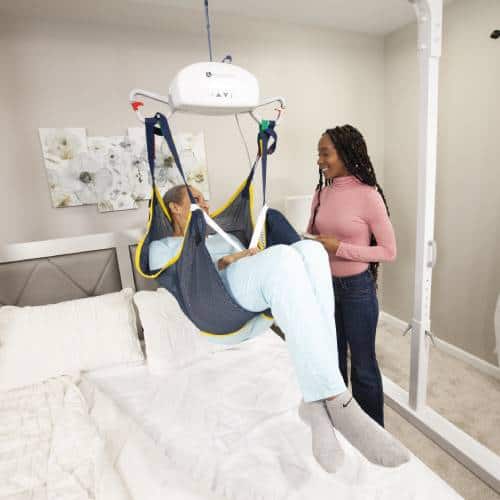Pressure ulcers can lead to dangerous sepsis, a blood infection that can be fatal. Are there ways to prevent pressure ulcers- or bedsores, as they are commonly called? Mobility aids could be key in reducing the incidence of pressure ulcers, thus eliminating the risks of sepsis in many patients.
Pressure ulcers cause pain, infection, and the risk of death to over 2.5 million people in this country. Pressure ulcers, sometimes called bed sores, are most common among those that are hospitalized or bedridden and can lead to sepsis- which can be fatal. So, how do you prevent pressure ulcers among those with physical limitations? The answer may lie in mobility aids and an increased awareness of the dangers of sepsis.
Where are you most vulnerable to these pressure ulcers? The most common locations of these sores on the body are:
- Hips
- Heels
- Tailbone
- Buttocks
- Elbows
- Back of head
- Shoulders
- Ears
- Spine
Sepsis Awareness Month in September strives to bring attention to the dangers and risks associated with bedsores and pressure ulcers.
Some mobility solutions that can prevent pressure ulcers include these aids:
Patient Lifts
Patient lifts help transfer and transport patients that have mobility issues or physical limitations. These can be a great help in ensuring patients are moved and not as susceptible to pressure sores when laid up or bedridden.
Furthermore, lifts take a lot of strain and risk off the caregiver’s shoulders. When caregivers are injured aiding their clients or loved ones, everybody loses. Make the commitment by investing in a portable lift, ceiling lift, or sling for the home environment.
Hospital Bed
As for the bed, a hospital-style bed with a gel mattress, or gel mattress overlay to protect and prevent pressure ulcers. This combination of a bed with the ability to angle and move as needed and the effective barrier between the bed and the patient’s skin are perfect for preventing sores caused by friction or pressure. The gel mattress is also lauded for better weight distribution which further helps protect the patient. Want to get a good night’s sleep? Invest in a new bed.
Wheelchair Cushions
Individuals that are confined to wheelchairs are at great risk of pressure ulcers. One way to help prevent a problem is to use a special gel or foam cushion that helps distribute weight and provide support. These are made to fit specific wheelchair models and can make the chair much more comfortable to sit in, too.
Heel Protectors
What is a heel protector? A heel protector is a protective guard that is worn when sleeping or laying down to protect the feet from pressure ulcers.
These are made to be adjustable and fit around the foot bringing your feet up and off the mattress. These are usually padded with foam, air, or a soft type of wool. These secure to the feet with Velcro closures typically and are crafted to be comfortable for the wearer. Talk to your mobility aids vendor about machine-washable covers to make it easy to keep them clean!
Blanket Lifters
When you are susceptible to pressure ulcers, the slightest weight or contact with skin can cause irritation, sores, and even infection. Individuals and caregivers must be vigilant to stay safe and to prevent the risk of sepsis.
When blankets, sheets, or other bedding rubs against the skin, it could potentially cause pressure sores for many. A blanket lifter provides a protective barrier, bringing the bedding and blankets up and away from the patient’s feet, legs, and skin. By alleviating the pressure, you are removing the risk of sores caused by bedding materials.
The blanket lifter is constructed with a metal frame that is installed between the user’s mattress and bed frame. It eliminates the friction that can lead to irritation and bedsores- and helps you sleep more comfortably. The design of most blanket lifters makes them compatible with most sizes and types of bed; talk to a mobility retail professional to learn more.
Bed Wedges
A bed wedge may seem like a simple thing, but it is quite a handy mobility solution that also can help prevent bed sores. The mesh-covered foam can be used in a variety of ways to relieve pressure and distribute weight differently when reclining, resting, or recovering in bed. Some patients use their wedge to prevent pressure sores on their tailbone, ankles, and even feet with much success.
Sepsis is an infection of the bloodstream that can contribute to lasting health and medical conditions. It is most common among older individuals over age 65- and impacts around 2.5 million people in this country. Observe Sepsis Awareness Month this September and learn more about protecting yourself- or someone you love- against the risks of blood infection. For mobility aids and devices, talk to the industry professionals at Pacific Mobility; call or visit today!
President, Husband, Father, Grandfather Graduate of UC Davis- Bio Sci Major- Go Aggies! Jeff has extensive experience in all of Pacific Mobility’s products and services, and specializes in accessibility products as well as stairlifts, ceiling lifts and custom wheel chairs. His hobbies include spending time with family, gardening, mountain biking, exercising and off road motorcycle riding.
24 years as Owner/President of Pacific Mobility Center – selling, installing, and servicing stairlifts, porch lifts, ceiling lifts, pool lifts, handicap ramping, specialty wheelchairs, scooters, power wheel chairs, and other power mobility devices
Certified Environmental Access Consultant since 2008
Licensed General Contractor since 1998
Certified Aging in Place Specialist since 2016
Board Member for Home Access Professionals
Member of Association of Members of the Accessibility Equipment Industry (AEMA)




